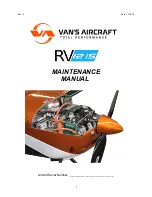
l
F.8L Falco Construction Manual
11–2
Revision 4, March 1, 2002
The drawings for the rudder ribs are badly out of scale. As noted in the revisions, the lightening
holes in the nose ribs are to be omitted.
Jigs
Ribs require some type of jig during their construction to insure accurate contours and
dimensions. The jigs for the vertical tail will only be used once, while the jigs for the wing and
horizontal tail will be used twice. Any experienced Falco builder will tell you that the jigging is
the most time-consuming part of building a Falco. The jigs do not need to be elaborate, but they
should be accurate.
Many of the ribs in the Falco are two and three piece ribs. In the wing there are even a couple of
four piece ribs at stations 1 and 2. Even though these ribs will be separate pieces when they are
glued in the airplane, they should be made as a single assembly to assure more accurate contours.
The ribs are cut apart for the spars after they are made. This way the rib capstrips take a
continuous bend. If each rib is made separately, the capstrips do not take the correct bend.
Draw the rib shape on a piece of 3/4” plywood and then overlay it with a sheet of wax paper or
polyethylene to prevent the glue from sticking to the jig board. Headless nails or small wood
blocks are used to outline the rib shape and to locate the positions of the uprights and diagonal
braces. The blocks should be shorter than the rib stock so that you can clamp and sand the rib
pieces only. Also, be sure to keep the blocks away from corners where they might be glued to the
rib, and they should allow for any corner blocking to be installed. It is best to use a single block to
locate the position of the spars. The corners of these blocks should be cut on the diagonal to stay
away from the glue. You do not have to be too elaborate with the jig, just locate the blocks
wherever necessary to hold the rib pieces in place and to the exact curvature required.
There are several methods for drawing the curved lines for the airfoil contours. The most accurate
method is to use a computer aided drafting (CAD) system. These systems are
extremely
expensive,
but if you have access to one, you may have the entire rib drawn on mylar. The rest of us will
have to use a flexible spline.
Keuffel & Esser Company sells a drafting spline, and this is what we use for doing the drawings
(K&E P/N 57-2849-36). This is a 36” long piece of clear plastic, about 3/16” by 5/16” in cross-
section. There are grooves at the top and bottom for “spline weights” which hold the spline in
position for drawing. The spline is aligned with the dimensioned points. The spline takes the
curve of the airfoil. You can sight down the spline and spot any irregularity before drawing. We
have found that French curves and flexible rulers are nearly useless for this type of work.
You do not have to purchase a drafting spline to do the same thing. A piece of wood will do as
nicely. You will find that model airplane stores sell strips of basswood, which may be used. If the
wood is of a consistent thickness and of clear grain, it will serve to make a smooth curve. You
may also be able to get a piece of plastic sheet from a local supplier. They are bound to have thin
pieces that they have cut off from larger sheets. A piece of 1/8” or 3/16” thick Plexiglas cut to a
width of 5/16”, 1/2” or more.
The gussets may be nailed, stapled or clamped in place when they are glued to the rib. If you plan
to use clamps, you should modify the jig slightly. First, cut the jig board to the approximate shape
of the rib, reducing its overall size as much as possible. Nail several blocks across the bottom of
the jig board so that it is elevated above the work table. This will permit you to place clamps on
each gusset. The glue and clamp method will require that you leave the rib in the jig until the
Summary of Contents for F.8L Falco
Page 1: ...F 8L Falco Construction Manual...
Page 7: ...l F 8L Falco Construction Manual Revision 4 March 1 2002...
Page 21: ...l F 8L Falco Construction Manual 1 8 Revision 4 March 1 2002...
Page 29: ...l F 8L Falco Construction Manual 2 8 Revision 4 March 1 2002...
Page 43: ...l F 8L Falco Construction Manual 5 4 Revision 4 March 1 2002...
Page 65: ...l F 8L Falco Construction Manual 9 6 Revision 4 March 1 2002...
Page 81: ...l F 8L Falco Construction Manual 10 16 Revision 4 March 1 2002...
Page 109: ...l F 8L Falco Construction Manual 15 4 Revision 4 March 1 2002...
Page 133: ...l F 8L Falco Construction Manual 17 10 Revision 4 March 1 2002...
Page 145: ...l F 8L Falco Construction Manual 18 12 Revision 4 March 1 2002...
Page 173: ...l F 8L Falco Construction Manual 21 10 Revision 4 March 1 2002...
Page 229: ...l F 8L Falco Construction Manual 23 40 Revision 4 March 1 2002...
Page 387: ...l F 8L Falco Construction Manual 28 26 Revision 4 March 1 2002...
Page 393: ...l F 8L Falco Construction Manual A 6 Revision 4 March 1 2002...











































